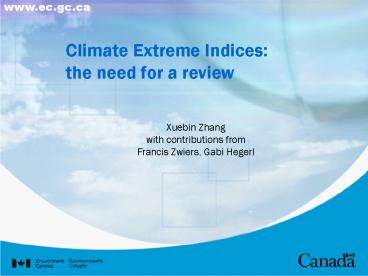Climate Extreme Indices: the need for a review - PowerPoint PPT Presentation
1 / 16
Title:
Climate Extreme Indices: the need for a review
Description:
Composite index: average of different indices ... yr for the first and second 50 years being added to the simulated temperatures. ... – PowerPoint PPT presentation
Number of Views:26
Avg rating:3.0/5.0
Title: Climate Extreme Indices: the need for a review
1
Climate Extreme Indicesthe need for a review
www.ec.gc.ca
Xuebin Zhang with contributions from Francis
Zwiers, Gabi Hegerl
2
Outline
- Objective
- Indices definition
- Indices calculation
- Indices application
- Composite indices
- Conclusions
3
Objective
- Two examples to show the need of a review
- Things need to be aware of in using indices
- Indices not as simple as they appear
- Not cover analysis in this presentation
4
A desirable index
- Easy to compute, and to update
- Easy to understand
- Physically meaningful
- High S/N ratio for climate change detection
- Impact relevant
- .
5
Definitions
- 27 ET indices
- Sub-set from early indices
- New method for computing percentile indices
- Regional and global analyses
- Indices defined by others (useful but can also be
confusion) - STARDEX indices (same name as ET but with
different meaning) - More indices better ?
6
The devil is in the detailsjump in percentile
indices
7
The devil is in the detailsjump in percentile
indices
8
The devil is in the detailsInfluence of obs
precision (N. America)
9
The devil is in the detailsInfluence of obs
precision (N. America)
10
Composite index regional average of same index
Kunkel et al. 2003
11
Composite index average of different indices
Schematic diagram illustrating changes in the
probability of extremes (the sum of occurrence of
much above and much below normal events) when the
mean of a normal distribution is shifted and the
variance remains the same. An increase in the
mean (X) results in a greater probabilities of
much above normal events (p1) and a decrease in
the probability of much below normal events (p2).
Due to the asymmetric nature in the density
function, p1 is larger than p2 with the net
change in the probability of much above and much
below normal events being p1-p2. Note that a
decrease in the mean will also result in an
increase in the probability of the much above and
much below normal events (modified from Zhang et
al. 2001).
12
Composite index regional average of different
indices
13
The U-shape of the index correctly indicates more
extremes towards the ends of series. When
temperature increases, the higher value at the
beginning of the series is due to more cold
extremes, but the higher value at the end is due
to more warm extremes.
Percentage occurrence of much above normal and
much below normal events for 344 climate
divisions in 10000 simulations. NO TREND
indicates no trend being added to the simulated
data. POSITIVE and NEGATIVE correspond to a trend
of 1/100-yr and -1/100-yr being added to all
climate divisions in the simulated temperature,
respectively. HALF shows a 1/100-yr trend added
to half of 344 divisions data and a -1/100-yr
trend added to the remaining half of the 344
divisions data. MIDDLE corresponds to a trend of
1/100-yr and -1/100-yr for the first and second
50 years being added to the simulated
temperatures.
14
Portion of Canada experienced Much Above and Much
Below normal precipitation, and Sum (All) of much
above and much below.
15
Composite indices summary
- Regional average of same index
- Average of different indices at one location
- Regional average of different indices
- Maybe useful for monitoring extremes, but
- Sth about extreme but no one understands what
precisely - Index damage not linear
- No one-to-one index damage
- Difficult to interpret physically
16
Future work
- Need a review to better understand indices and to
inform genernal users (indices not as simple as
they appear!) - Definition (link to application)
- Calculation (details important)
- Analysis (trend, climate change detection)
- An ET guide on?
- Development and application of indices
- Consider regional difference
- Consider sectorial difference
- More attention on application (impact relevance)
- Other suggestions































